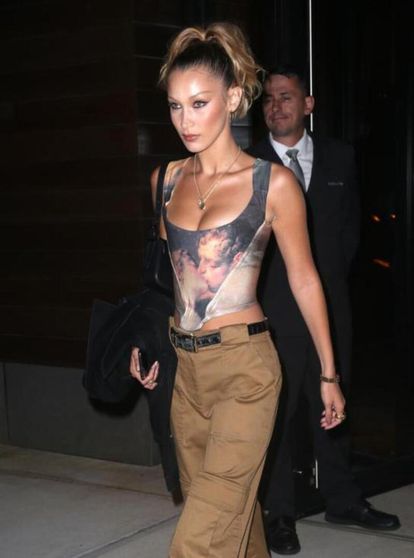When the first images of Timothée Chalamet and Kylie Jenner as a couple were leaked in early September, social media went crazy, as expected. Less expected was the fact that many users were surprised by Jenner’s outfit: a Martin Margiela dress from 2008 with a horse print that belongs to one of the Belgian designer’s best-remembered collections, which came out a year before he permanently retired from the catwalk. Shortly after the photos of Jenner and Chalamet embracing at the Beyoncé concert were “leaked,” Kylie — an expert at making the most of publicity — announced that she was the new face of the Swedish firm Acne Studios. The millennial generation knows both Margiela and Acne as niche brands, that is, cult brands for a fashion-savvy minority that are sometimes purchased because they are only recognized by (and recognizable to) fashion connoisseurs. That is quite different from the silent luxury phenomenon, which represents its expensive products as normal, basic garments. In contrast, niche fashion is characterized by pieces that are “difficult” to wear and have an ugly component and/or an unusual silhouette.
But the fact that a brand like Acne Studios — which is famous for its work with artists, deconstructed patterns and cult magazine Acne Paper — has chosen someone like Kylie Jenner as the face of the brand, announces the direction in which things are headed. Just a few days before that announcement, a girl’s story about how her Tinder date stole her Tabi — Margiela’s toe-splitting shoes, which the designer borrowed from Japanese footwear and made his own in the late 1980s — went viral on TikTok. It’s neither easy nor cheap to wear Tabi (they cost over a thousand dollars). Nevertheless, the shoes have apparently become common knowledge among thousands of people. What happened that something traditionally known to only a few has now become so widely popular?
The first reason can be found in the macro-trend in which young people feel nostalgia for moments and cultural expressions that they did not live through themselves: “This has led them to relaunch many products from 20 years ago or more. Sixty-seven percent of the Baguette bags that Fendi has launched and 57% of the archive models that Marc Jacobs has relaunched on the market have sold out,” they explain in a report by Edited, a platform that collects online sales data to advise brands. The report adds that “Dior and Rick Owens are some of the best-loved brands; because they generate the most views on TikTok, they are the most valued on resale platforms.”
If today’s thirtysomethings’ clothing whims are limited-edition sneakers or Supreme clothing, younger people are opting for brands that were previously niche. Shortly after her death, Vivienne Westwood’s pieces from the 1980s and 1990s went up in value: in the latest report from Poshmark, a luxury resale website, they argue that searches for the punk designer’s vintage handbags rose by 310%. TikTok is partly to blame. Its structure — infinitely looping videos designed to capture the user’s attention — prioritizes storytelling over images. At first, the virality of certain products, such as Tabi or Rick Owens boots, comes from the designer’s own story, but then it is driven on social media by young people’s current desire for the items. A designer who has always inspired an extreme cult following (many of his devotees dress exclusively in his clothing, if they can afford it), Owens uses his Instagram account to post his advertising campaigns, but he shares his eccentric daily life on his TikTok page. Therein lies the difference. With big brands working for years as entertainment companies that blend music, film or television with the catwalk — there’s a reason why Yves Saint Laurent is producing films and Kering, the holding company to which it belongs, just bought the CAA talent agency — fashion itself has become a pop phenomenon. Hunting for, acquiring and even collecting vintage garments by cult designers serves as yet another form of public amusement.
“The culture and conversations around fashion have changed over the last couple of years. The marketable cross-pollination of fashion with other industries, such as entertainment and technology, have helped turn this once-underground subculture into a spectator sport with fanaticism rivaling that of actual sports or pop music,” journalist Jose Criales-Unzueta wrote in i-D of the viral Tabi case. “As a result, once niche and subversive designers who flew under the radar — such as Y/Project’s Glenn Martens, Ann Demeulemeester and Raf Simons — have started to gain die-hard fans, on and offline.” But it’s not all about luxury: in the past year, Birkenstock’s Boston clogs and Uniqlo’s fanny pack, which costs around $21, have also become cult favorites. In fact, the data platform Lyst included those items on its list of the most-wanted products in the first six months of this year, alongside Prada handbags, Balenciaga shoes and Bottega Veneta jewelry. “Based on our list, it is clear that fashion is going through a chaotic time. The most famous brands have given us incredible shows and memorable appearances, but the data reveals that people want something much more complex now,” Lyst commented in its report.
Strange shoes from niche brands, hard-to-wear clothes, excessive jewelry and cheap accessories that don’t usually show up on the trend circuit: TikTok and nostalgia have given rise to all these things. Of course, so have trendsetting celebrities, who have recently been photographed wearing Yamamoto, Jean Paul Gaultier, Mugler or Margiela garments from 20 or 30 years ago. In other words, for the past couple of years, celebrities have been wearing clothing with history and powerful creative concepts behind them that, until recently, were worn exclusively by gallery owners, artists and those who could afford to wear luxury items known only to a few fashion connoisseurs. Stylists like Law Roach (who dresses Zendaya and Gigi Hadid) and Dani Michelle (who styles Kylie Jenner and Hailey Bieber) set their very famous clients apart from all the other trendsetters by choosing to dress them in hard-to-find clothes that, until now, were also difficult to recognize.

The theory of luxury consumer marketing, which was first proposed in 2010 at the University of Southern California and gained popularity among analysts of the phenomenon, divided consumers into four categories: poseurs (who buy the items for the logo), parvenues or the new rich (who purchase luxury goods to get noticed), patricians (who buy exclusive brands that are unknown to most people) and proletarians (those who lack access to luxury). Fortunately, that theory no longer applies. The luxury barrier is now exclusively financial; it is no longer segregated by knowledge or access. And if the minority is now the majority and the past is now the present, what sense does it make to talk about seasonal trends in fashion?
Sign up for our weekly newsletter to get more English-language news coverage from EL PAÍS USA Edition




